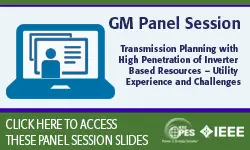-
Members: FreePES
IEEE Members: $45.00
Non-members: $70.00Pages/Slides: 51
27 Aug 2001
Forward Voltage fluctuations and lamp flicker have been issues in electric power systems from the early days of electrification. Indeed, as early as the 1920s, researchers were studying the effects of flickering lamp output on human observers and trying to correlate the responses ofthese observers with fluctuations in the voltages supplied to the lamps. After numerous experiments, traditionally using incandescent bulbs, a clear trend emerged that correlated the irritation reported by the observer to the measurable change in voltage supplied to the lamp. In graphical form, this correlation became known as a flicker curve. The flicker curve is traditionally a plot of voltage magnitude changes as a function of the frequency ofchange, where the change is assumed to be of square wave shape. Calculated voltage-frequency points that are "above" the plotted flicker curve indicate that flicker complaints may be a problem, while other points "below" the curve would not likely represent a problem. This method has served the industry very well for many years; voltage flicker curves derived from the original research in the early 20th century were still in widespread use in North America through the mid-1980s. Two relatively recent developments have created an environment where a new look at voltage fluctuations and lamp flicker should be considered. First, modem end-use equipment has the potential to create voltage fluctuations that deviate significantly from the assumed square-wave shape associated with the traditional flicker curve. Second, the globalization ofthe modern economy has necessitated the use of standards with international familiarity and acceptance. With these two motivating factors, the Task Force on Light Flicker has considered the adoption of the existing flicker practices of the International Electrotechnical Commission (IEC) together with the significant additional original (and ongoing) work by the International Union for Electroheat (UIE). This tutorial document is an in-depth overview ofthe UIE/IEC flicker practices, methodologies, and standards. Because these techniques are well-recognized outside North America and because they offer tremendous potential to overcome the shortcomings of the traditional flicker curve, the Task Force on Light Flicker has developed this tutorial for the benefit ofthe practicing engineer working with voltage fluctuations and lamp flicker. After careful study ofthis material, the advantages of the UIE/IEC approach should be clear. Mark Halpin (Mississippi State University), Tutorial Organizer and Editor Larry Conrad (Cinergy Corp.), Task Force Chair Reuben Burch (Alabama Power Company), Task Force Secretary
Primary Committee:
Power Engineering Education Committee
Sponsor Committees:
Transmission and Distribution Committee


